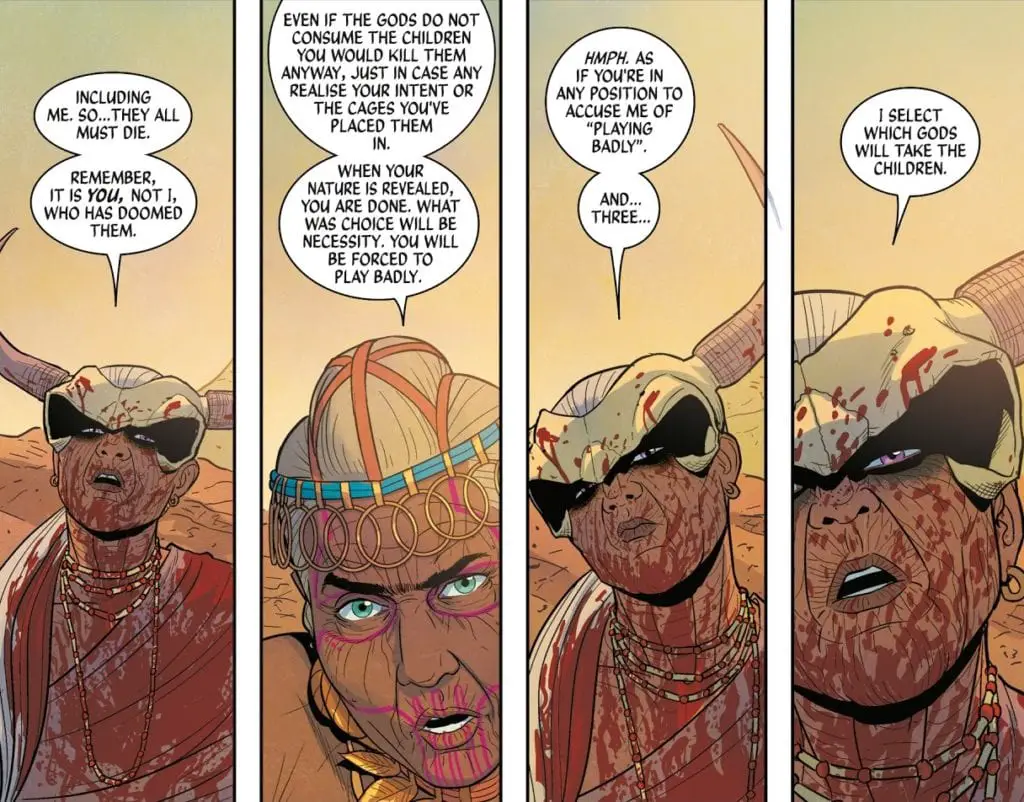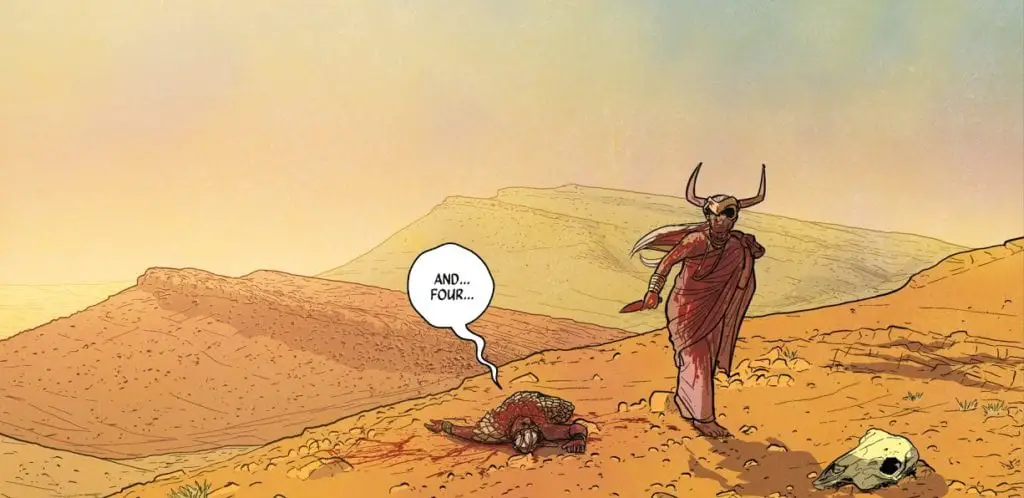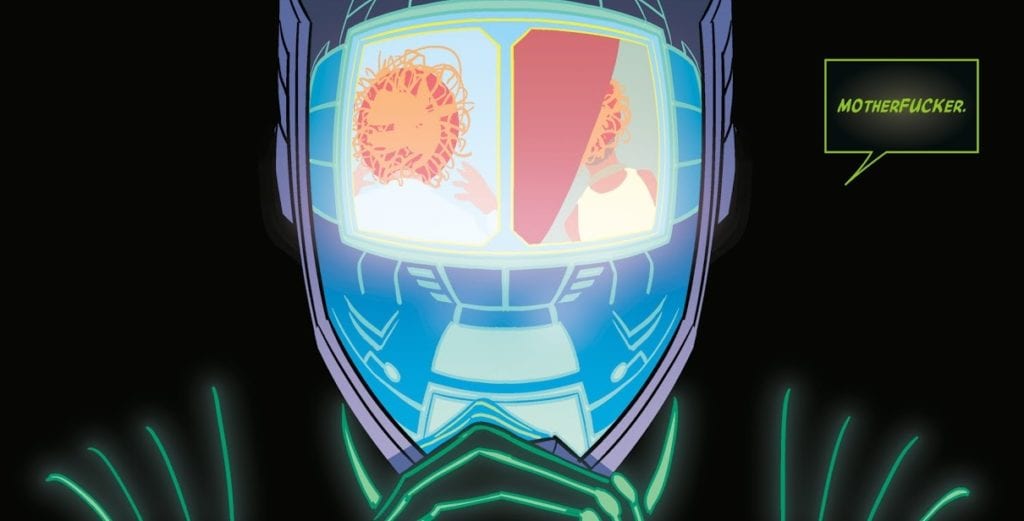The ‘enigma’ factor can imbue a story with a very special charm, a feeling of depth and gravity beyond the immediately apparent. Character motivations, arcs and whatnot all become more interesting when you’re aware there’s a large portion of truth still far away from reach. However, this resource is also prone to mishandling, resulting in outrageous contrivances or an overall feeling of laziness to outline a narrative’s inner logic. Fortunately, this has been far from the case in The Wicked + The Divine, especially when it comes to She who’s shaped up to be the Big Bad: Ananke.
We readers have come to think of her, the Matron-caretaker, as an extension of the paradigm that sets the gods’ reincarnations and short lifespans. But a stark change fractured this unity of character and paradigm. Her godslaying tendencies eroded on her credibility, and that of the rules we’ve been playing by. Even so, it would be simplistic to think of her as merely a villain. Both her motivations and ultimate intent are doused in mystery, as well as her actual current state of existence. Intriguing.
This new issue is the start of the most recent WicDiv arc: Mothering Invention, as well the second to final part in the series. The end draws near, and with it, a likely denouement for Ananke’s endgame. So, what better way to embark on these final acts than by a major reveal? That may not sound like much, given how the past issue was a major reveal on its own right. But today we get to know how the Recurrences’ gig began, 6000 years ago.
Issue #34
“‘Forever’ makes liars of us all.”
The goddess featured in this cover isn’t strictly one we’ve seen before, but a few visual cues should prove different. At first sight, it may be easy to link this character to Ananke, if only for the fact of looking pretty old. Yet the skull tattoo and those three dots under her right eye are a definite visual cue to Persephone. She remains unnamed throughout this issue, however, and I think that’s more fitting than calling her a “Proto-Persephone.” The world’s oldest known religion is that of the Sumerians, dating 4500 to 1900 BC. Both the arid setting and the characters’ garb lend feasibility to this story taking place in that setting. However, both Ananke and Persephone belong to the Greek pantheon, which may mean they are younger configurations to these two ladies here.

Syncretism is a fascinating thing indeed, especially considering “Proto-Persephone” looks like something of a Mother Goddess throughout this issue. Nonetheless, for the sake of convenience, I’ll call them Ananke and Persephone: two actual goddesses in the flesh. Now, on to the events proper.
Persephone and her grandson are in the middle of running away from Ananke, whose means in this stage of history are far less discreet than in the 21st Century. Persephone urges her grandson to escape on his own, as she has one last scene to play out with her sister, who catches up soon after. Ananke’s “grand design” has progressed nicely; she has claimed the heads of four other gods and sewed their lips shut to keep them quiet. Sounds kind of familiar, eh? It bears mentioning these heads look pretty diverse in terms of race and motifs, so we’re probably looking at other early incarnations of gods from all over the world. That’s a lot of work alright, and the next step is to commit fratricide, as you do.
Now, there are two devices in particular that set ancestral narratives as foundational landmarks. One such device is blood, of which there is plenty in these panels. Another is storytelling itself. Story and rite basically dictate reality, going by the coherence of early human civilization. Herein lies Persephone’s final gambit to resist Ananke. Or more accurately, to disrupt Ananke’s corruption of the narrative (already featured in her willingness to commit kinslaying). To do so, she has to outwit her sister via wordplay. We should note, the use of theatrical vocabulary in this issue is likely a nod to the dominance of a narrative. All have a role to play, whether humans or gods. Knowing this may benefit her, Ananke agrees and kicks off.
While striving to outwit the other, both sisters outline the rules for the Recurrences. This means that, for one purpose or another, both Ananke and Persephone are playing the long game. One appears to seek mortality, the other to stop her from further warping the paradigm. I exercised a lot of interpretation, and I’m sure they could be debated, but the rules are as follows:
One, Ananke will have two forms, the Maiden and the Crone, whereas Persephone will have the mother. This is, of course, a tight link to the motif of the threefold goddesses we see reprised in several pantheons. I personally also interpret this as Ananke “being” Minerva (Maiden) and herself (Crone).
Two, there will always be twelve gods; they will be aware of this, and they each must be gone before the end. Persephone sets this rule while (probably) being purposefully vague. She hints that their lifespan won’t necessarily be just those two years, and she’s also not saying whose end she means. This gap in information may prove a hopeful note, but also an incentive for Ananke to actively get her hands dirty.

Three, Ananke will always choose what gods the ‘children’ will be reincarnated as. Persephone’s god, however, will be in each Recurrence, but they will awaken last, as per Ananke’s design. Like a kick in the crotch, this is a most direct link to the current Pantheon, as Persephone was the last god to awaken. And, going by the first rule, probably representing the Mother. Therefore, it makes a whole lot of sense that post-modern age Ananke would go to such lengths to demonize Persephone (Laura Wilson). She is her sister’s gambit made flesh. All said and done, the rules are set. Ancestral Persephone doesn’t cower before her inevitable murder at her sister’s hands.
Ananke invokes those haunting words she’d pronounce at the end of all Recurrences: “I love you. I’ll miss you.” Such sweetness never sounded so ominous. Knife in hand, she pounces like a serpent and commits the deed. However, as she walks away, Persephone pronounces a final rule with her dying breaths. Number four… We don’t get to know what rule number four is. It may be that it allows for Persephone-Laura to be born as the thirteenth god without it being cheating. Or it could be something else, the prospect of which is enticing also.
This issue ends with a leap into the future—our present. Verdandi and Skuld are enjoying a coffee in Valhalla, when their divinity is suddenly stripped away. Boo. In the mean time, while under captivity, Laura and Cass have a chat with Jon. There’s some emotional relief here for pretty much everybody, a little inner monologue for Laura (hinting at a secret yet to be revealed as well as some healthy self-awareness), and some awkward stuff regarding Mimir being just a head. The former Norns arrive just in time to try and free them. However, Laura is quick to notice Woden isn’t doing anything to stop them.

Truth is, his attention is elsewhere. He has just come to find that disturbing link between Minerva and (the late?) Ananke. Get stoked, lovelies. We’re at that point where we can expect the unpredictable, still with a nice bulk of issues waiting ahead. Of course, this will turn to anxiety and tears when we get there, but who really cares? Rejoice!
Images Courtesy of Image Comics
The Wicked + The Divine Issue #34 Credits
Writer: Kieron Gillen
Art / Cover: Jamie McKelvie, Matt Wilson

